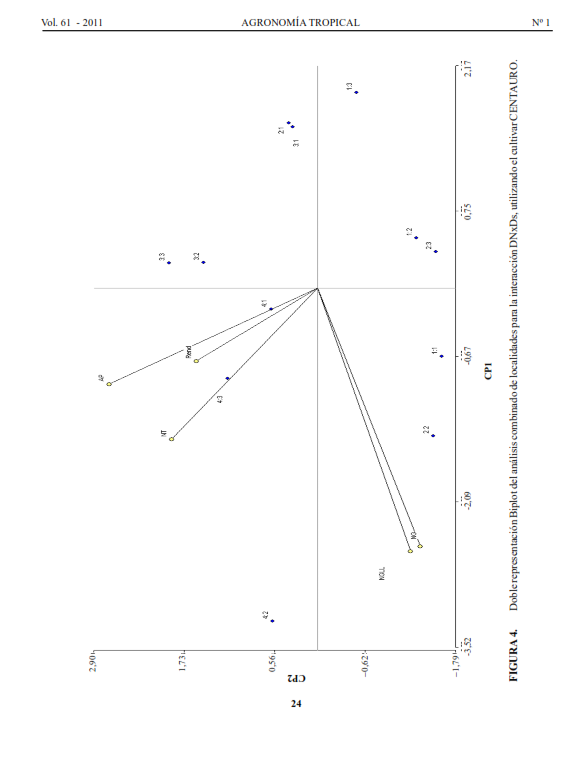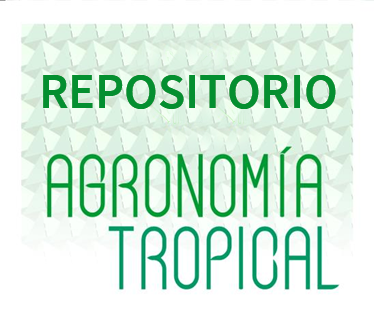Effects of planting density and nitrogen fertilization on the grain yield of rice cultivar Centauro in Venezuela
Abstract
In order to evaluate the effect of planting density and nitrogen fertilization on the grain yield, Oryza sativa l. of Centauro, trials were established during the 2006-2007 irrigation cycle in the three main production areas of the country. The design was a randomized complete block arranged in stripes, the (DN) is located in the main plots and (Ds) in the secondary plots with three replications. grain yield was evaluated in kg ha-1, adjusted to 12% moisture. Analyses of variance were conducted individual and group, Tukey means analysis and multivariate analysis of principal components. The analysis individually and group by location allowed to detect significant differences (P≤0.01) for DN in all locations and significant differences Ds in Barinas, DNxDs interaction was highly significant in Barinas and guárico, while in Portuguesa it was not detected possibly due to high experimental variation. All these results suggest that the cultivar Centauro presents a differential response to nitrogen application (120 ≤ DN ≤ 200) kg ha-1 for grain yield. The group analysis of the sources of variation in DN, Loc, DNxDs, and DNxLoc were significant at 1% and 5%, respectively. The variation is a predominance in the locations, followed by DNxloc, DN, and DNxDs. It was found that the principal components analysis and the use of dual representations (Biplot) are useful for studying the interaction of both factors (DNxDs.
Downloads
References
• Counce, P. 1987. Asymptotic and parabolic yield and linear nutrient content responses to rice population density. Agronomy Journal, Madison. 79(5):864-869.
• Cuevas-Pérez, F., l. Berrio, D. González, F. Correa- Victoria and E. Tulande. 1995. Genetic improvement in yield of semidwarf rice cultivars in Colombia. crop Science, Madison, 35(3):725-729.
• David, C. and K. Otsuka. 1994. Modern Rice Technology and Income Distribution in Asia. lynne Riener publis- hers, Colorado. United States of America. 475 p.
• De Datta, S. K. 1981. Principles and Practices of Rice Production. International Rice Research Institute (IRRI). Los Baños. Philippines. 618 p.
• De Datta S., E. Craswell, R. Filley, J. Calabio and F. García. 1981. Alternative strategies for increasing nitrogen fertilizer efficiency in wetland rice soil. Annual International Rice Research. coference, april 27 de may 1. International Rice Research Institute (IRRI), los Baños-Philippines.
• De Datta, S. and F. Broadbent. 1988. Methodology for evaluating nitrogen utilization efficiency by rice genotypes. Agronomy Journal, Madison, 80:793-798.
• Fageria, N. K., N. Slaton and V. Baligar. 2003. Nutrient management for improving lowland rice productivity and sustainability. Advances in Agronomy. 80:63-152.
• Gindri, S., M. Souza e V. Mussoi. 1996. curva de resposta à aplicação de nitrogênio para quatro genótipos de arroz irrigado. Avoura Arrozeira. 49:3-6.
• Hotelling, H. 1933. Analysis of a complex of statistical variables into principal components. Journal of Educational psychology. 24:417-441.
• Infeld, J. e E. P. Zonta. 1987. Densidade na BR-IRGA 411. In: Reunião da cultura do arroz irrigado, 14. Pelotas. Anais. Pelotas: Embrapa-CPATB/UFPel, 168-172 pp.
• InfoStat, 2002. InfoStat profesional. Software versión 1.1. estadística. Universidad Nacional de Córdoba, Argentina.
• Kumura, A. 1956. Studies on the effect internal nitrogen concentration of rice plant on the constitutional factors of grain yield. Japan. proc. crop. Sci. Soc. 24:177-180.
• Martínez, P. 1998. Situación del cultivo del arroz en Venezuela. Fundación polar, 1er Ed. 39 p.
• Páez, O. 1991. El cultivo de arroz: densidad de siembra, control de malezas y fertilización. FoNAIAp Divulga 36:26-28.
• Páez, O. y C. Barrios. 1995. Efecto de la interacción densidad de siembra-lamina de agua sobre el crecimiento, desarrollo y producción de arroz en época de verano. Rev Fac de Agro. 12:25-45.
• Páez, O., G. Rico y l. Velásquez. 2004. El cultivo de Arroz en Venezuela. Nutrición y Fertilización en Arroz. Instituto Nacional de Investigaciones Agrícolas. Maracay, Venezuela. 202 p. (Serie manuales de cultivo INIA N° 1).
• Pedroso, B. 1987. Densidade e espaçamento entre linhas para arroz (Oryza sativa l.) irrigado. lavoura Arrozeira, porto Alegre. 40(370):6-6.
Pulver, E. y P. Jennings. 1997. El papel de Fundarroz en la industria arrocera en Venezuela. Mimeografiado. 17 p.
• Ramalho, M. A., J. B. Santos e C. A. Pinto. 2000. Genética na agropecuária lavra. Lavras: UFLA. 404 p.
• Rieffel, N., S. Ferreira Da Silva, P. Gaedke, P. Menezes E C. Paim Mariot. 2000. Resposta de genótipos de arroz irrigado ao arranjo de plantas. Pesq. Agropec. Bras., Brasilia. 35(12):2 383-2 390.
• Rico, G. y S. K. De Datta. 1982. Diferencia varietal del arroz en la utilización del N del suelo, bajo condiciones de riego, usando 15N. Agronomía. Trop. 32(2):171-185.
• Rico, G., D. Pérez, J. Ledezma, J. Parra y H. Agrinzones. 1992. Efectos de diferentes niveles de nitrógeno y fósforo en variedades modernas de arroz bajo condiciones de inundación en suelos pesados. Agronomía Trop. 42(1-2):41-52.
• Rodríguez, H., l. Arteaga, R. Cardona, M. Ramón y l. Alemán. 2002. Respuesta de las variedades de arroz “Fonaiap 1” y “cimarrón” a dos densidades de siembra y dos dosis de nitrógeno. Bioagro 14(2):105-112.
• Statistical Analysis System. 2002. SAS Institute Inc. guide for personal computers. Release 9.1.3. USA.
• Scivittaro, W. e M. Machado 2003. Adubação e calagem para a cultura do arroz irrigado. In: gomes A., y Magalhães Junior, A. (org). Arroz irrigado no Sul do Brasil. Brasília-DF: Embrapa Informação Tecnológica, 2004. cap. 9:259-303 pp.
• Silva Da Souza, l., H. Bohnen, E. Marcolin, V. Regina, M. Macedo e E. pocojeski. 2007. Resposta a doses de nitrogênio e avaliação do estado nutricional do arroz irrigado. Revista Brasileira Agrociência, pelotas. 13(2):189-194.





